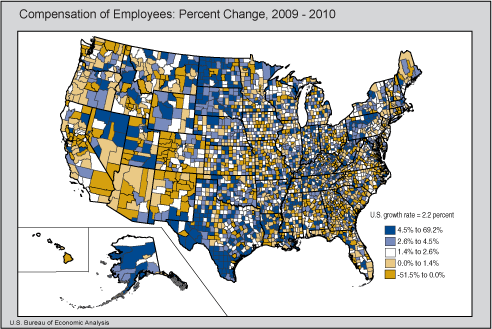News Release
County Estimates of Compensation by Industry, 2008-2010
Regional Highlights
Compensation in large counties
Compensation in large counties–counties with at least $10 billion in total compensation–represent 5 percent of the 3,113 counties in the U.S., but account for almost two-thirds of total national compensation. In these 170 large counties:
- Total compensation grew by 2.2 percent in 2010, ranging from 9.8 percent in Santa Clara County, California to -4.3 percent in San Mateo County, California
- Increases in finance and insurance and professional, scientific, and technical services were the largest contributors to the growth in 2010 total compensation
- The professional, scientific, and technical services sector represented the largest share of 2010 total compensation at 10.9 percent
- Average annual compensation per job grew by 2.9 percent in 2010, ranging from $46,438 in El Paso County, Texas to $116,047 in New York County (Manhattan), New York
Compensation in medium counties
Compensation in medium counties–counties with total compensation of at least $1 billion and less than $10 billion–represent 22 percent of all U.S. counties, and account for 26 percent of total national compensation. In these 682 medium counties:
- Total compensation grew by 2.1 percent in 2010, ranging from 44.8 percent in Williams County, North Dakota to -11.1 percent in Maury County, Tennessee
- Increases in health care and social assistance and federal government were the largest contributors to the growth in 2010 total compensation
- The health care and social assistance sector represented the largest share of 2010 total compensation at 12.7 percent
- Average annual compensation per job grew by 2.4 percent in 2010, ranging from $33,333 in Sevier County, Tennessee to $105,474 in North Slope Borough, Alaska
Compensation in small counties
Compensation in small counties–counties with total compensation of less than $1 billion–represent the remaining 73 percent of all U.S. counties, but account for only 8 percent of total national compensation. In these 2,261 small counties:
- Total compensation increased by 2.1 percent in 2010, ranging from 69.2 percent in Mountrail County, North Dakota to -51.5 percent in Trimble County, Kentucky
- Increases in durable-goods manufacturing and health care and social assistance were the largest contributors to the growth in 2010 total compensation
- The local government sector represented the largest share of 2010 total compensation at 17.2 percent
- Average annual compensation per job grew by 2.8 percent in 2010, ranging from $28,618 in Keweenaw County, Michigan to $101,431 in Eureka County, Nevada
¹Beginning with 2009 statistics, new county equivalents were created for Alaska: Petersburg Census Area (02-195) and Wrangell City and Borough (02-275) take the place of the former Wrangell-Petersburg Census Area (02-280). Part of Prince of Wales-Outer Ketchikan Census Area (02-201) was annexed by Ketchikan Gateway Borough (02-130) and part (Meyers Chuck Area) was included in the new Wrangell City and Borough. The remainder of Prince of Wales-Outer Ketchikan Census Area was renamed Prince of Wales-Hyder Census Area (02-198).
Definitions
Compensation is the income received by employees as remuneration for their work. Compensation is the sum of wage and salary disbursements and supplements to wages and salaries. Supplements to wages and salaries consist of employer contributions for government social insurance and employer contributions for employee pension and insurance funds. Compensation is reported by place of work. The level of personal income in the national income and product accounts (NIPAs) differs from the national total in the state personal income statistics because of differences in coverage and the timing of the availability of source data. See Personal Income in the NIPAs and State Personal Income for more information.
Technical notes
The 2008–2009 statistics have been revised to incorporate newly available source data, while the 2010 statistics are released for the first time.
In addition to the county statistics, BEA is releasing compensation by industry for metropolitan areas, metropolitan divisions, micropolitan areas, combined statistical areas, and BEA economic areas. Table CA06, Compensation of Employees by Industry, for all areas for 1998–2010 can be accessed interactively at /iTable/index_regional.cfm.
Tables presenting the comprehensive measure of personal income for local areas–including CA05, Personal Income by Major Source and Earnings by Industry–will be released April 25, 2012. The release of 2011 local area Personal Income statistics will be accelerated by five-months, scheduled for November 26, 2012.
Detailed personal income statistics for metropolitan statistical areas, micropolitan statistical areas, metropolitan divisions, and combined statistical areas are available on the BEA Web site at www.bea.gov
By visiting BEA's Web site, you can also subscribe to e-mail notifications of BEA's various news releases and announcements.
